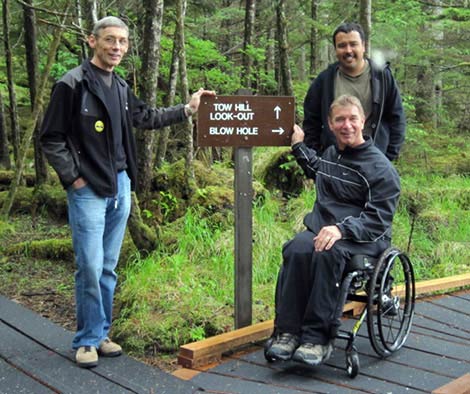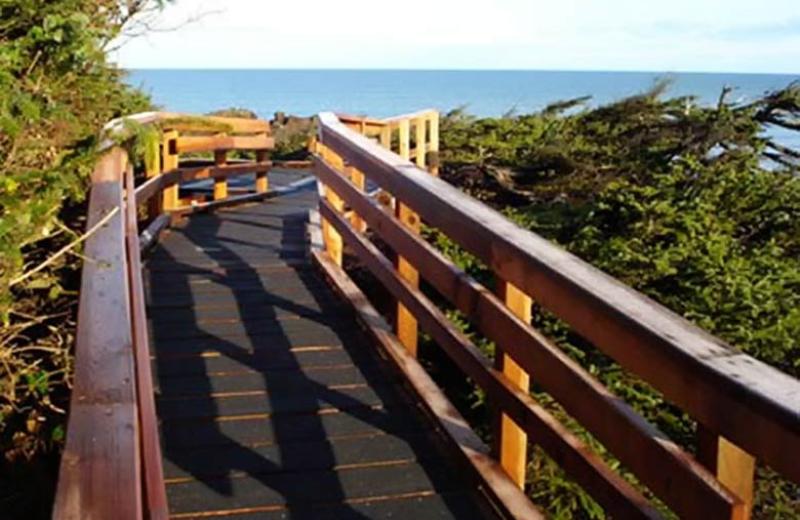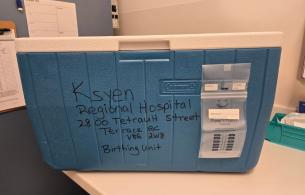Naikoon Park on Haida Gwaii is a wild and pristine coastal site in the traditional territory of the Haida Nation. Naikoon has long been a place of spiritual and cultural importance for Haida people. Visitors seek it out for the long stretches of unspoiled beach, coastal rainforests, dunes, and wetlands.
Prioritizing accessibility
A few years ago local officials looked to improve the trails in Naikoon (namely the famous Tow Hill trail) and decided to prioritize accessibility. Ultimately, learning about accessibility went beyond the trail – the whole community continues to benefit from a new perspective in building and development.
John Disney is the Economic Development Officer with Old Massett Village Council and took up the duty to make a wholly new trail type for Naikoon.
"We decided to work together [with the Province of BC and accessibility advocates] to run the park in a manner that would be attractive and all-inclusive. On that actual site [Tow Hill], we've rebuilt the whole thing. That was our first attempt at launching this new approach and seeing what the result would be. The first person we took out there, when we first opened it, was Rick Hansen! His face was just beaming! He was up onto the boardwalk and down the beach; we could hardly keep up to him. He told us it was great and he said, 'You've got to keep going in this direction.' He gave us his stamp of approval!
You can take a virtual hike before you even arrive! Once you're here, you can wheel all the way down the boardwalk, ending at a platform right on the rocks. Visitors can go up to a sign and feel the braille, or hear a story from one of the on-site 'talking signs' in English or Haida. When the West wind is blowing and the waves are crashing, they may have the salt spray on their faces … this is very exciting.
It's not like Stanley Park here. It's pristine, it's raw, and when you're out, you're out in the elements. I don't know why people have ever thought that those living with disabilities aren't interested in that – they crave it. How can they find it? That's what we're learning now."

The positive reception has been gratifying for Disney and his team who toiled on making this project a reality, from securing support and funds, to boardwalk design and the tough work of building it. In fact, support for this project has been so strong that further work on park trails will carry on with a similar focus, extending the wilderness experience for all people in new ways:
"I can't wait to tell you this! Another trail branching off of the current, accessible one is the start of an old homestead trail. It crosses over the island to the east coast. We were going to just upgrade it but I thought to consider making that trail accessible too. I worried that it may be too long, so I called up Rick Hansen and asked him if the idea was insane. He wouldn't even let me finish my sentence; he said, 'John, build it!' So we're moving forward with this dream. We're going to build a 10 km trail through pristine old-growth forests and marshlands, ending on the Hecate Strait beaches – and you're going to be able to do the whole thing in a wheelchair.
The old trail had a bunch of steps, now they'll have to be turned into ramps so that you can wheel up them, or push a buggy up them. You can ride your bike up them! Suddenly options open up."
Disney makes it clear that learning about accessibility has deeply impacted his work – and his service has impacted many aspects of visitor and community life:
"To tell the truth, I never really understood that there's a segment of our society that can't get to these places. It never occurred to me, but now it has and it's a different way of looking at things. Accessibility is now one of the things we take into consideration when we build. When we build a cabin, is it accessible? Has it got a ramp? We built a 12-unit apartment for the community a few years ago and ensured that one whole floor was accessible. We wanted to be sure that the kitchen, the bathrooms, and everything worked for people in wheelchairs.
Whenever we are building something new we have to make it accessible. We have to be aware that whatever it is, there are people who will want to use it that were never were able to before. I've gained a new understanding and it's brought me a lot of gratification too, to know that now I've learned this, I can do something about it."
More information
- Take a virtual hike of Tow Hill
- Canada's Most Accessible Park? Haida Gwaii Opens Wheelchair-Friendly Boardwalks and Virtual Hike (Spinal Cord Injury BC article)
This article first appeared in Healthier You magazine. Find the original story and lots of other information about accessibility in the Fall 2016 issue.














Comments